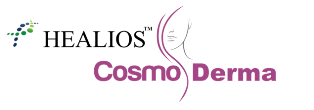Is Your Scrub Giving You Wrinkles?
Have you ever wondered if scrub or exfoliation is an essential and beneficial part of your skincare routine and, if so, how often should you exfoliate? Well, there might be something else to consider – exfoliating too often causes your skin to age faster than it normally would if you didn’t ever exfoliate.
What Is Exfoliation ?
Exfoliation involves the removal of the oldest dead skin cells on the skin’s outermost surface.They are beneficial for temporary correction of epidermal problems but have no beneficial effect on dermal problems, such as wrinkles or scars, regardless of how many times they are repeated. Healing is rapid (3 to 6 days) after an exfoliating procedure.
Types Of Exfoliation
In general, exfoliation can be classified as “natural,” “induced,” or “false.” Natural exfoliation is innate and involves daily shedding of mature, nonviable cells from the upper stratum corneum.
Natural exfoliation is the body’s natural method of continually renewing the epidermis and maintaining its barrier function. It is impaired or slowed down with advanced age, overuse of moisturizers, and the use of oil-based cosmetics; it can be accelerated by manual
friction or rubbing.
Induced exfoliation results from various concentrations of topical AHAs, beta-hydroxy acids (BHAs), and kojic acid. These substances disrupt the hemidesmosomal bonds between corneocytes and, to some extent, between keratinocytes. more specifically, the topical application of AHAs (glycolic, lactic, citric, and malic acids), which are water soluble, leads to exfoliation of individual corneocytes and keratinocytes, whereas the application of BHAs
(e.g., salicylic acid), which are lipid soluble, “melts” cells through keratolysis.
False exfoliation refers to stratum corneum dehydration leading to subsequent exfoliation induced by topically applied tretinoin, benzoyl peroxide, or several other agents. With these specific agents, groups of cells are shed (coarse exfoliation).
Why the skin’s turnover rate slows down with age ?
The skin slows down its turnover rate because it has fewer nutrients available to it. Every year of adult life – roughly after the age of 25 – the skin loses 1 percent of its circulation, which provides the needed components to maintain healthy metabolism in the skin, including the replacement of the epidermis.
On that timeline, a typical 40-year-old woman has 15 percent less circulation and, therefore, 15 percent less capacity to maintain all the activities of the skin. Her turnover rate can also be expected to be 15 percent slower, which equals about five days or 35 total days to renew her epidermis. If it is necessary, the skin can go into emergency response mode, such as after a chemical peel, for example, and rapidly replace the damaged layers in a few weeks. This rapid renewal shows that the skin is not unable to keep up turnover, but that it chooses not to. However, in normal maintenance mode, the skin will slow the turnover rate so that it has enough nutrients to make a complete barrier.
Other parts of the body that already start with less circulation will have even longer epidermal renewal times. Through exfoliation, the skin’s barrier is being damaged because it removes some of the 15 DNA-designed layers of stratum corneum. Repeated Exfoliation will force the skin into emergency response mode to restore itself faster than it wants.
The skin slows down the renewal process because it wants to hold on to nutrients for dermal functions and emergency responses. By depleting dermal stores, the skin will be less able to maintain dermal collagen, which results in more wrinkles. It also means less immune repair activity; therefore, managing daily sun damage is compromised. This problem becomes even worse when it is acknowledged that removing protective epidermal layers increases free radical damage from the sun.
When acids or devices are used to exfoliate the skin, a wound response is initiated. This response increases epidermal swelling, which temporarily plumps the skin and makes fine lines look better. This result, however, does not last and has nothing to do with new collagen; it is merely instant gratification that has led to the strong attraction to these methods. If a few layers of epidermis are removed, the skin will have to make more collagen sooner than it wanted to, causing the collagen-manufacturing machine to be redirected for epidermal reasons. It would be better to allow the skin to stay focused on dermal collagen, since that is the key aspect of a wrinkle. Any collagen made for a damaged barrier is temporary and is not the long-term collagen that the skin desperately needs.
How to avoid excessive exfoliation?
In order to avoid over-exfoliating the skin, it is important to be aware of how many exfoliants you are employing. Check to see whether your day and night moisturisers contain exfoliating enzymes and/or acids, such as AHA or BHA. Are you using these alongside a toner or a serum with similar exfoliating agents? Does your daily cleanser contain these acids and/or a scrub agent (micro-beads, apricot kernel, etc.)?
Are you using an abrasive sponge, brush or handheld electric device to cleanse your skin? Do you regularly have peels or microdermabrasion? If you are using more than one of the exfoliants listed above, more than two or three times a week, you will certainly be over-exfoliating and, especially in the case of sensitive and ageing skin, this will damage your skin.
In summary, do not be over-zealous with exfoliation and, if you are experiencing redness, breakouts or dryness, cut out exfoliation altogether from your skincare routine until your skin heals and then, especially if you have sensitive or ageing skin, restrict exfoliation to no more than once a week. And always consult your dermatologist regarding the cosmetics that you use.
Related
 Posted by admin
Posted by admin- Posted in Skin Care
 Aug, 28, 2018
Aug, 28, 2018 No Comments.
No Comments.

 7975288129 / 7483528607
7975288129 / 7483528607
